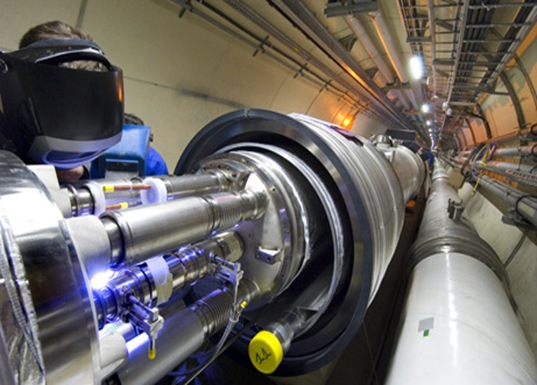Full-power operation of the Large Hadron Collider (LHC) won't happen until early spring 2009, after an electrical glitch sparked a large helium leak inside the machine's tunnels.
Although repairs should take just about two months, the collider needs to be shut down in the winter to save costs. Officials with the European Organization for Nuclear Research (CERN) therefore decided not to restart the particle accelerator until next year.
"Coming immediately after the very successful start of LHC operation on 10 September, this is undoubtedly a psychological blow," CERN Director General Robert Aymar said in a press release.
"Nevertheless, the success of the LHC's first operation with beam is testimony to years of painstaking preparation and the skill of the teams involved in building and running CERN's accelerator complex.
"I have no doubt that we will overcome this setback with the same degree of rigor and application."
"Last Hurdle"
Twenty years in the making, the world's largest atom smasher, built near Geneva, Switzerland, was designed to investigate dark matter, the big bang, and other mysteries of the early universe. (Interactive: understanding the God particle.)
Operators hurled the first beam of low-energy particles through the collider's 17-mile (27-kilometer) underground track just over a week ago.
The successful test had officials hopeful that they could start smashing opposing beams of particles together in as little as two week's time.
But during a routine test on September 19, an electrical link failed between two of the machine's massive 30-ton superconducting magnets, which guide speeding particles through the track.
"What we know indicates there was a faulty connection between two cables joining two magnets together that warmed up to the point of melting and that resulted in helium being leaked into the tunnel," CERN spokesperson James Gillies told National Geographic News.
No one was hurt during the malfunction, and the problem has been confined to a roughly two-mile (three-kilometer) swath of the track.
"This was actually the final electrical test of the final electrical circuit for qualification for running at high energy," Gillies said.
"This would have been the last hurdle."
"Teething Troubles"
The delay is due to the fact that the collider's operating temperature inside the track is -456.3 degrees Fahrenheit (-271.3 degrees Celsius).
For engineers to fix the problem, the section has to be warmed up, repaired, and cooled back down, a process known as a thermal cycle.
The thermal cycle for the LHC is about two months.
"The thing that went wrong [at the LHC] is not such a big deal," said Mike Harrison, a high-energy physicist at Brookhaven National Laboratories in Upton, New York.
"The actual fix will be a day or two probably," he said. "The problem is you have to warm it up and cool it down again. That's what takes up time."
Harrison added that this kind of delay is just part of the process of getting a particle accelerator ready for business.
He was involved in the design and fabrication of Brookhaven's Relativistic Heavy Ion Collider (RHIC), a smaller version of the LHC that's been in operation since 2000.
"You expect to have probably a couple of thermal cycles as you go through the commissioning process" of a particle accelerator, Harrison said.
CERN's Gillies agreed that "teething troubles" are inevitable with a machine as complicated as the LHC, and that other particle accelerators have faced similar problems.
"It's one of those things you have to be ready for when you start to operate a machine like this," he said.
"It's just more time-consuming with a superconducting machine, where you have a warm-up and a cool-down phase involved with any repair."
And also check:













0 comments:
Post a Comment